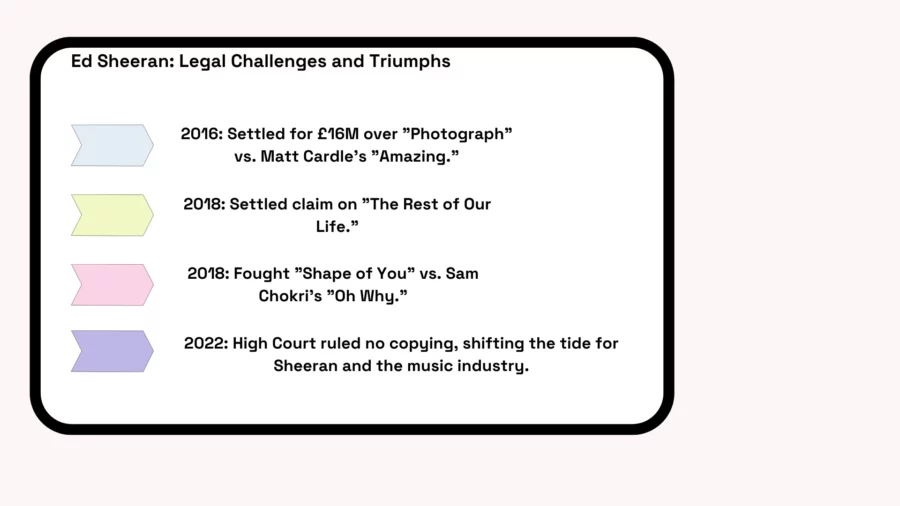Key Takeaways:
- Copyright infringement is using someone else’s creative work without permission. This can harm artists and their livelihoods.
- Copyright law protects artists’ work and gives them rights to control how it’s used.
- Artists can protect their work by registering their copyright, using copyright notices, and monitoring for infringement.
- It’s important to comprehend fair use, which allows limited use of copyrighted material in certain contexts.
Art is an essential aspect of human creative expression and artistic. Artists pour their hearts and souls into their work, spending countless hours perfecting their craft.
However, when someone else takes credit for an artist’s work or uses it without permission, it can be devastating. This is where infringement comes in.
In this blog post, we will look into some of the most significant artist copyright infringement cases, exploring the facts of each case and their outcomes.
We will also discuss the steps they can take to protect their work
Protect Your Brand & Recover Revenue With Bytescare's Brand Protection software
What are the Copyright Infringement Cases in Music Industry?
Copyright infringement cases in music often involve disputes over unauthorised use, copying, or sampling of original blocks of music musical compositions, lyrics, or sound recordings. Let’s look at some famous copyright infringement in music examples.
Here are some notable examples of copyright infringement in music:
Marvin Gaye’s Estate vs. Robin Thicke and Pharrell Williams
In 2013, Marvin Gaye’s estate accused Robin Thicke and Pharrell Williams of copying Gaye’s 1977 song “Got to Give It Up” in their hit single “Blurred Lines.”
In 2015, a jury found Thicke and Williams guilty of copyright infringement and ordered them to pay over $7 million in damages, later reduced to approximately $5 million on appeal.
George Harrison vs. Bright Tunes Music
In 1976, a court ruled that George Harrison’s song “My Sweet Lord” infringed the copyright of the Chiffons’ 1963 song “He’s So Fine.”
The court found that Harrison had subconsciously copied the melody, and he was ordered to pay damages to Bright Tunes Music.
The Verve vs. The Rolling Stones
The Verve’s 1997 song “Bitter Sweet Symphony” used a sample from an orchestral version of The Rolling Stones’ song “The Last Time.”
Although The Verve had initially obtained a license for the sample, the court found that they had used more than the agreed-upon amount.
As a result, The Verve had to relinquish all royalties and songwriting credits for “Bitter Sweet Symphony” to The Rolling Stones’ publisher.
Tom Petty vs. Sam Smith
In 2015, Tom Petty’s publisher claimed that Sam Smith’s song “Stay with Me” had a similar melody to Petty’s 1989 song “I Won’t Back Down.”
The case was settled out of court, with Smith agreeing to share songwriting credits and royalties with Petty and co-writer Jeff Lynne.
Queen and David Bowie vs. Vanilla Ice
In 1990, Queen and David Bowie accused Vanilla Ice of sampling the bassline from their 1981 song “Under Pressure” without permission for his hit “Ice Ice Baby.”
Vanilla Ice settled the case out of court, paying an undisclosed sum and granting Queen and Bowie songwriting credits for “Ice Ice Baby.”
Famous Artists Sued for Copyright Infringement

Numerous famous artists have faced copyright infringement lawsuits and copyright claims throughout the years. Here are some high-profile cases examples:
- Ed Sheeran: Ed Sheeran has faced multiple infringement lawsuits. In one case, he was accused of copying elements of Marvin Gaye’s “Let’s Get It On” in his song “Thinking Out Loud.” In another case, songwriters Martin Harrington and Thomas Leonard claimed Sheeran’s “Photograph” had striking similarities to their song “Amazing.”
- Katy Perry: In 2019, Katy Perry was found guilty of copyright infringement in a lawsuit filed by Christian rapper Flame. The court ruled that Perry’s song “Dark Horse” had copied a musical segment from Flame’s song “Joyful Noise.”
- Robin Thicke and Pharrell Williams: In a high-profile case, Marvin Gaye’s estate accused Thicke and Williams of copying Gaye’s song “Got to Give It Up” in their hit “Blurred Lines.” In 2015, a jury found the artists guilty of copyright infringement and ordered them to pay over $7 million in damages, later reduced to approximately $5 million on appeal.
- Led Zeppelin: The band faced a lawsuit claiming that their iconic song “Stairway to Heaven” had copied parts of the instrumental song “Taurus” by the band Spirit. In 2016, a jury ruled in favor of Led Zeppelin, finding no copyright infringement. The decision was upheld on appeal in 2020.
- Madonna: In 2012, Madonna was sued by VMG Salsoul, who claimed that her song “Vogue” sampled a horn segment from the 1976 song “Love Break” by the Salsoul Orchestra. In 2016, the court ruled in favour of Madonna, stating that the sampled segment was too minimal to be considered copyright infringement.
Protect Your Brand & Recover Revenue With Bytescare's Brand Protection software
4 Artist Copyright Infringement Cases in India
1. The Napster Case
In 2000, Napster, an American music-sharing website, faced legal action from Indian music label T-Series for alleged copyright infringement.
T-Series accused Napster of enabling users to illegally download and share its copyrighted music, which violated its intellectual property rights.
Napster was a peer-to-peer file-sharing service that allowed users to share music files with each other, bypassing traditional music distribution channels.
2. The Barfi Case
In 2012, the makers of the Bollywood movie ‘Barfi!’ found themselves embroiled in a plagiarism lawsuit controversy when the grandson of renowned Indian filmmaker Bimal Roy sued them for allegedly copying elements of his grandfather’s 1955 film ‘Jalsaghar’.
3. Mohenjo Daro Case
In 2016, the makers of the Bollywood movie ‘Mohenjo Daro’ faced accusations of plagiarism when an American writer sued them for allegedly copying his unpublished novel.
The writer claimed that the movie’s plot, characters, and even some dialogue had been lifted from his work without his permission or credit.
The American writer argued that the similarities between his unpublished novel and Mohenjo Daro were too close to be coincidental, asserting that the filmmakers had access to his manuscript.
He accused the filmmakers of intellectual property theft, claiming that his creative ideas were used without consent.
4. The ‘Tattoo’ Case
In 2018, a tattoo artist based in Mumbai filed a lawsuit against Indian movie star Hrithik Roshan, alleging copyright infringement.
The artist claimed that Roshan had used one of his tattoo designs without permission in the movie ‘Krrish 3’. The design element in question was a tribal tattoo that appeared on Roshan’s character in the film.
The tattoo artist argued that the design was his original creation and that using it in Krrish 3 without proper consent violated his copyright.
He sought compensation, claiming that the movie’s wide reach gave the tattoo significant exposure, potentially affecting his authorship rights as the creator.
The case highlighted the issue of copyright protection in non-traditional art forms like tattoos, sparking debates about how intellectual property laws apply to artistic works displayed on public figures in commercial films.
Additional Copyright Infringement Cases

1. The Statute of Anne (1710)
The Statute of Anne, also known as the Copyright Act 1710, was an important milestone in the development of copyright law. It was enacted by the British Parliament to address the rampant piracy and unauthorised printing of books that were prevalent at the time.
The law granted authors and publishers a limited monopoly over their creative works, giving them the exclusive right to print and distribute their works for a period of 14 years. This marked a significant departure from previous laws that had granted monopolies to printers rather than authors.
The Statute of Anne also allowed authors to renew the copyright for an additional 14 years if they were still alive, empowering creators with greater control over their intellectual property.
This act laid the foundation for modern copyright law.
2. Baker v. Selden (1879)
Baker v. Selden was a landmark case that helped to clarify the scope of copyright protection for ideas and systems.
The case involved an argument for copyright infringement between Charles Selden, the author of a book on accounting methods, and Frederick Baker, who had created a set of forms based on Selden’s methods.
Baker had produced a set of accounting forms that he claimed were based on the principles laid out in Selden’s book.
However, Selden argued that Baker’s forms were a direct copy of his book, and therefore constituted copyright infringement.
The U.S. Supreme Court ruled that while Selden’s book was protected by copyright, the accounting methods and systems described in it were not.
The case established the important distinction between the expression of ideas, which is protected by copyright, and the ideas or systems themselves, which are not.
3. F.W. Woolworth Co. v. Contemporary Arts, Inc. (1979)
F.W. Woolworth Co. v. Contemporary Arts, Inc. was a landmark case that helped to establish the concept of “fair use” in copyright lawsuits.
The case involved a dispute between the retailer F.W. Woolworth Co. and the artist Dan Flavin, who had created a series of light sculptures using coloured fluorescent tubes.
Woolworth had produced a series of Christmas decorations that were similar in design elements to Flavin’s light sculptures.
Flavin sued Woolworth for copyright infringement, arguing that the decorations copied his original work.
The court ruled in favor of Dan Flavin, finding that Woolworth’s decorations were too similar to his sculptures and infringed on his copyright.
This case reinforced the importance of distinguishing between permissible “fair use” and unauthorised copying, further shaping the legal framework around how artistic expression is protected in commercial contexts.
4. Sony Corp. of America v. Universal City Studios, Inc. (1984)
Sony Corp. of America v. Universal City Studios, Inc. was a landmark accusations of copyright infringement case that helped to clarify the legal status of devices that could be used to copy copyrighted material, such as video cassette recorders (VCRs).
The case involved a dispute between Sony, the manufacturer of VCRs, and Universal City Studios, which claimed that VCRs were illegal because they facilitated the unauthorised copying of copyrighted movies and TV shows.
The U.S. Supreme Court ultimately ruled in favor of Sony, determining that VCRs had substantial non-infringing uses, such as time-shifting (recording shows to watch later), which constituted fair use.
This decision set an important precedent for the legality of technology that can be used for both lawful and unlawful purposes, significantly influencing later actions for copyright infringement.
5. Google LLC v. Oracle America, Inc. (2021)
Oracle claimed that Google had copied thousands of lines of Java code without proper permission, while Google argued that it had used only the necessary code under fair use.
The U.S. Supreme Court ruled in favor of Google, stating that its use of Java’s API was protected under the doctrine of fair use because it enabled innovation and did not unfairly harm Oracle’s market.
This case significantly impacted software development. It clarified how copyright law applies to APIs and functional code, fostering greater flexibility for developers in building interoperable software systems.
This case clarified API copyright law, promoting innovation by ensuring developers can use functional code under fair use principles.
6. Walt Disney Copyright Infringement Case
The Lion King (1994): In 2003, the family of South African writer and artist Solomon Linda filed a lawsuit against Disney, alleging that the song “The Lion Sleeps Tonight” used in the movie The Lion King was based on Linda’s song “Mbube”. The lawsuit was eventually settled out of court for an undisclosed sum.
Pirates of the Caribbean (2003): In 2005, screenwriters Terry Rossio and Ted Elliott sued Disney, alleging that they had been underpaid for their work on the Pirates of the Caribbean franchise. The case was settled out of court for an undisclosed sum.
Zootopia (2016): In 2017, artist Gary L. Goldman filed a lawsuit against Disney, alleging that the studio had stolen ideas and characters from his pitch for a movie called “Zootopia”. In 2019, a judge dismissed the case.
Frozen (2013): In 2015, author Isabella Tanikumi filed a lawsuit against Disney, alleging that the movie Frozen was based on her autobiographical book “Living My Truth”. In 2016, a judge dismissed the legal battle.
7. Patrick Cariou Copyright Infringement Case
This copyright infringement lawsuit involved legal battles between photographer Patrick Cariou and artist Richard Prince.
Cariou had published a book of photographs titled “Yes, Rasta,” which featured images of Rastafarians and their culture in Jamaica.
Prince, an artist known for his appropriation of existing images, created a series of paintings based on Cariou’s photographs, which he titled “Canal Zone.”
Cariou sued Prince for copyright infringement, arguing that the paintings were not transformative enough to qualify for fair use. The court ultimately ruled in favor of Prince, finding that his works were transformative as they added new meaning and context to the original photographs.
This case raised important questions about the boundaries of artistic appropriation and the interpretation of fair use in the art world.
Protect Your Brand & Recover Revenue With Bytescare's Brand Protection software
How to Safeguard Your Work from Copyright Infringement?
If you want to safeguard your work from copyright violations, there are several steps you can take:
- Copyright Registration: Registering your copyright with your country’s copyright office can provide you with legal protection and make it easier to enforce your intellectual property rights if your work is ever infringed.
- Use copyright notices: Include a copyright notice on all your original works, including the copyright symbol (©), your name, and the year of publication. This serves as a warning to potential infringers and makes it clear that you are the owner of the work.
- Keep records: Keep detailed records of all your original works, including when they were created, when they were published, and any changes or revisions you have made. This can help you prove ownership in the event of a copyright dispute.
- Limit access: Limit access to your original works by using password protection or other security measures. This can help prevent unauthorised copying and distribution.
- Monitor your work: Regularly search the internet and other sources for instances of copyright infringement, and take action if you find any. Consider using online tools that can help you monitor your work, such as reverse image search engines.
- License your work: Consider licensing your work through a Creative Commons license or other licensing agreement. This can allow others to use your work in specific ways while still protecting your rights.
What’s Next?
Bytescare offers a robust solution to protect artists’ work from copyright infringement, emphasising the critical need to shield intellectual property rights.
Through cutting-edge technology, Bytescare digital piracy monitoring actively monitors the internet for unauthorised use of artists’ creations, ensuring their creative efforts are safeguarded.
By providing real-time alerts and facilitating the removal process of infringed content, Bytescare empowers artists to maintain control over their work. This proactive approach not only secures artists’ livelihoods but also reinforces the respect and value of their contributions.
In fostering a respectful environment, Bytescare plays a pivotal role in promoting a culture of creativity and innovation, benefiting artists and society alike.
Ready to secure your creative work? Book a demo with Bytescare today and take the first step towards comprehensive copyright protection.
The Most Widely Used Brand Protection Software
Find, track, and remove counterfeit listings and sellers with Bytescare Brand Protection software

FAQs
What is artist copyright infringement?
Artist infringement occurs when someone uses an artist’s work without permission or in a way that violates the artist’s rights.
How can artists protect their work?
Artist can do following things mentioned below to protect their work from violation:
Register copyrights: Register with your copyright office for legal protection.
Use watermarks: Discreetly embed watermarks to discourage copying.
Track online presence: Monitor websites and platforms for unauthorized use.
Control online sharing: Grant licenses for specific usage, not ownership.
Seek legal help: Consult a lawyer if infringement is suspected.
Can an artist sue for copyright infringement?
Yes, artists can sue for copyright infringement if their work has been used without permission or in a way that violates their rights.
What is fair use in copyright law?
Fair use is a legal doctrine that allows for limited use of copyrighted material without permission for purposes such as criticism, commentary, news reporting, teaching, scholarship, or research.
Can I use copyrighted material in my own artwork?
It depends on the circumstances. In some cases, using copyrighted material in your own artwork may be considered fair use, but in other cases it may be considered infringement.
How can artists avoid copyright infringement when referencing other works?
Artists can use copyrighted material through “fair use” if it’s transformative, doesn’t replace the original market, and uses only a portion of the work. However, fair use is complex and requires careful consideration.
Consulting a lawyer and knowing the specific legal context is essential to ensure responsible use of copyrighted material.
What can artists do to protect their work from copyright infringement?
Artists can protect their work by registering their copyright, using copyright notices, keeping fantasy records, limiting access to major record labels, and monitoring their work for infringement.
Ready to Secure Your Online Presence?
You are at the right place, contact us to know more.

